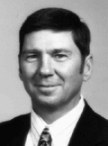What's happening in exploration
December 1997 Vol. 218 No. 12 Exploration A.E. (Al) Hutchins, Jr., Technical Editor SEG annual convention awesome The Society
SEG annual convention awesomeThe Society of Exploration Geophysicists (SEG) held its 67th annual meeting and international exposition in Dallas last month. An all-time record number of exhibitors displayed products and services. More than 360 companies used an area the size of seven football fields to showcase the latest technology available in seismic hardware and acquisition as well as computer power to process and utilize seismic data. Software developments / improvements to enhance processing, storage and retrieval of the vast amounts of data used by geophysicists were abundant. For the third year in a row the SEG sold books at the convention at a record pace. Registered delegates totaled 10,087, not a record, but consistent with the last few years' attendance. The employment referral booth was well attended by companies; however, there was one problem—there were not enough resumes being submitted by people looking for work. This emphasizes the fact that the manpower shortage in our industry is affecting all disciplines. Fred Hilterman, outgoing SEG president, pointed out in his keynote speech that, when he graduated from Colorado School of Mines in 1963, more than 15% of graduates were geophysicists compared to only 3% in 1997. Hilterman referred to financial analysts touting improved technology as the principal driver for the oil industry recovery. Directional and multi-lateral drilling, subsea completions and floating production systems (to mention only a few) are increasing production and lowering costs. However, Wall Street is listing 3-D seismic and higher success rates as the primary driver. To enhance the final product, and shorten seismic processing time in sub-salt areas, gravity surveys are coming to the forefront. A company here in Houston, LCT, has a new software product that applies high-resolution gravity and magnetic data to seismic velocity modeling. The company has a large data bank of gravity surveys to work with, and provides gravity and magnetic acquisition. Also, Bell Geospace acquired a 10-year exclusive license to Lockheed Martin's gravity gradiometry technology. This 3-D FTG (full tensor gradient) technology was developed as a stealth navigational tool for the U.S. Navy. Dr. Bosko Loncarevic, president of Pinetree Information Technology, said, "This is the most significant technological breakthrough at the convention." Many geophysicists believe using this data to define salt structures before performing 3-D depth migration will become essential. In collaboration with eight major oil companies, using Navy vessels, the company has already acquired gravity gradiometry over most of the deepwater, Gulf of Mexico discoveries to date. The surveys cover 800 blocks and include Brutus, Bullwinkle, Diana, Fuji, Gemini, Jolliet, Luna, Marquette, Mars, Mickey, Popeye, Ram-Powell and Vancouver. The company plans to offer surveys to the industry utilizing a leased vessel that has been reconfigured. Bayous and bays. From the bayous of Louisiana to Bohai Bay off China, Apache Corp. is finding oil and gas. On its Zhao Dong block, the company reported a discovery on the "C" segment of the block in Bohai Bay. Well C-4 discovered high-gravity oil at depths greater than those encountered to date on the block. It is the first well in this area to test oil from Mesozoic-age sediments. The discovery well tested at a combined rate of 15,359 bopd and 6.1 MMcfgd from eight separate oil zones. An additional, non-associated, gas zone produced 4.6 MMcfgd. Eleven productive zones totaling nearly 400 ft of net pay were tested. Two Mesozoic-age formations between 7,530 and 7,710 ft and nine Tertiary-age, Shahejie zones between 5,955 and 6,990 ft were tested. The Shahejie is the primary producing reservoir in the North China basin. In Vermilion Parish, Louisiana, the company announced a new pay discovery in Pecan Island field. The Apache-operated Goodyear 2 well flowed at a daily rate of 8.2 MMcfgd and 415 bbl condensate. The well was tested on a 14/64-in. choke with a flowing tubing pressure of 8,490 psi. Perforations are between 14,614 and 14,692 ft in the Miocene-age A-5 sand. Potential production was indicated in the A-2, A-4 and A-6 Miocene sands which will be tested through another scheduled well, Goodyear 3. The first well in the field, Goodyear 1, has produced nearly 1.2 Bcfg and 280,000 bbl condensate from the A-6 sand since completion in May 1996. Apache holds 1,200 acres in the field and plans to drill two additional wells early next year. Other working interest owners in the new pay discovery are Araxas Exploration (21%), Key Production Corp. (17%) and Eland Energy (5%). Internet access. Exxon announced that its subsidiary, Esso Exploration and Production Chad, Inc. will make available, on the Internet, environmental and other information on its proposed oil development project in southern Chad. The website is www.essochad.com. The project, if approved, will target nearly one billion bbl of reserves over the life of the project. A pipeline, from the oil field in Chad to the port of Kribi in neighboring Cameroon, will be required. Exxon's partners in the $3-billion project are Shell (40%) and Elf (20%). Esso Chad has been selected by the consortium to act as operator. According to Exxon, the website is designed to help ensure that people worldwide have access to information about the project. It will contain information on the economies of Chad and Cameroon as well as a description of the project, including the planning and public consultation process. A summary of the Chad Environmental Assessment (EA), related issues and news releases regarding the project will also be posted. The EA is designed to assess environmental, social and economic effects of the proposed
project. Extensive public consultation activities have been underway in Chad, Cameroon,
Europe and the U.S. since 1993. Copyright © 1999 World
Oil |



